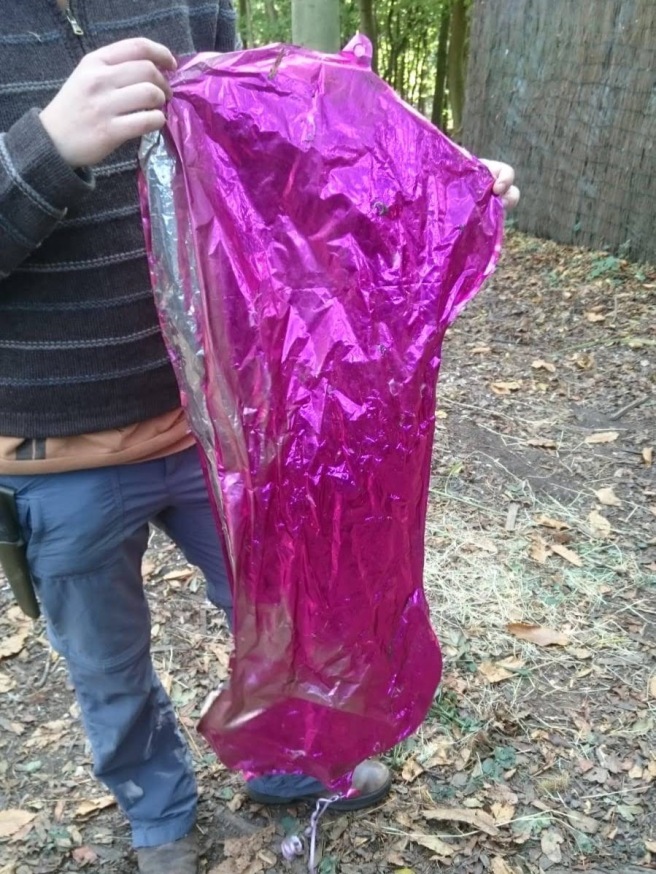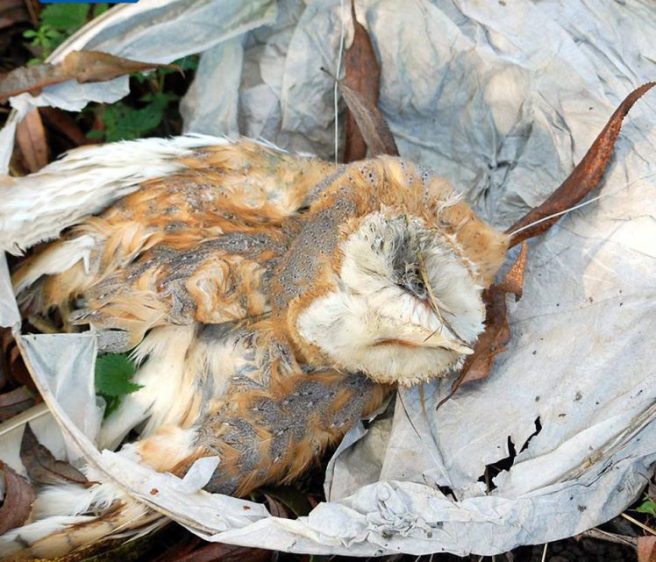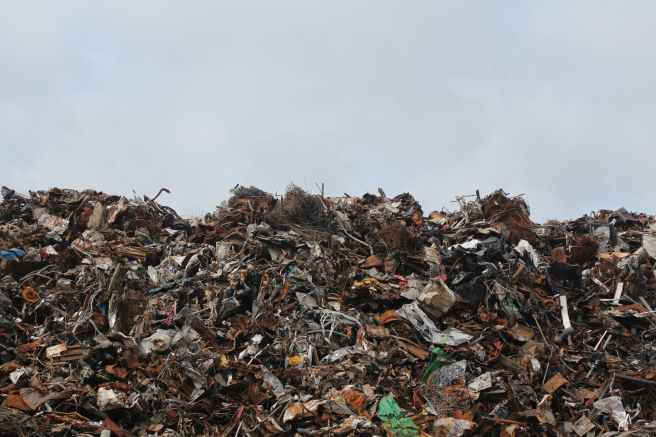The natural world is so busy and full of beautiful, remarkable things to pay attention to that it sometimes causes me problems when I help out at the bushcraft school where I was privileged enough to spend many of my weekends this summer. I frequently find myself going out to collect firewood and coming back, some considerable time later, with a pocket full of sweet chestnuts, an interesting skull, twenty photos of an interesting beetle on my phone (only one of which even approaches reasonable resolution) and a meagre handful of twigs gathered in a desperate hurry when I remembered what I was supposed to be doing. On this occasion my fickle attention was captured by something draped in a thorn hedge, of a vivid pink colour rarely found in nature and even more incongruous in an autumnal Kentish woodland.
Quite a few scratches and scrapes later I reached it. The bushcraft camp is in a private woodland up a steep hill; this in combination with a highly environmentally conscious instructor means I rarely spot any visible litter so it was quite jarring to find a large fuschia pink foil balloon defacing the hedge. I retrieved it and headed back to camp, hastily grabbing an armful of sticks on the way.

Foil balloons are made from a thin layer of Mylar plastic, a non-biodegradeable petrochemical product, covered with an equally non-biodegradeable layer of aluminium foil. (It should be noted that while regular latex balloons do eventually biodegrade this can take several years, during which period they can still be ingested by wildlife). Both of these seem like ridiculous substances to be releasing into the winds to be scattered over the countryside and into the oceans. Using and releasing helium balloons seems especially ridiculous as the helium used to fill them is a nonrenewable resource that we divert from such frivolous uses as medical scanners in order to divert it to the vital endeavour of filling our skies with trash.
I do realise that this is a sensitive subject as balloon releases are often used to commemorate loved ones who have passed on, and people in mourning don’t necessarily make the most sensible decisions and nor should they be expected to, but quite honestly if anyone I loved decided to commemorate my passing with an act of mass littering I’d probably spontaneously come back to life simply to die of embarrassment at them all over again.
As well as falling as litter, balloons are known to have been responsible for the death of at least one animal, a horse that choked on one and broke her legs and neck running around her field in panic. I would imagine they have been responsible for far more; the death of a valuable thoroughbred horse made the papers in a way that the deaths of other less economically valuable livestock may not, and wild animals are unlikely to be recorded at all. And ingestion is not the only threat, it doesn’t seem unlikely that strange things floating in the sky could spook highly strung animals like horses into a panic in which they could injure themselves.
Incidentally while I’m on the subject of pointless airborne litter, sky lanterns are also a source of litter, a menace to wildlife and to make things even more fun also set things on fire when they come down.

This depressing woodland discovery left me wondering why people release these things, where they think they go to when they can no longer see them. We live in a closed system, do people not realise that there’s no “away” for the things we create to go to? This of course leads to the follow up question of where people think materials come from. Since the excellent Blue Planet Two, the problems caused by single-use plastics have rightly received a lot of attention, but do I worry that we’ve gone slightly off track by focusing on the “plastic” part to the exclusion of the “single use” part.
I’ve certainly seen a few occasions when efforts to avoid a particular material have lead to even more consumption; my local wholefood shop sells metal bottles reusable water bottles that come with plastic lids as standard, and supplementary metal lids “for people who choose to avoid plastic” – presumably people who buy these are throwing away the original lids that come with the bottles leading to twice as much consumption. A popular post in a sustainable living group I used to belong to encouraged people to make their own beeswax wraps, cotton fabric impregnated with beeswax, as a an alternative to clingfilm by melting the beeswax in a baking tray before soaking the cotton in it. I fancied giving this a try and asked the original poster how she cleaned the baking tray afterwards, to be told that she got a cheap one from the pound shop and just threw it away afterwards! Something has gone very wrong with our thinking when we’ll buy a metal object, with all the resource costs that went into extracting and moulding it, and then throw it away rather than cleaning it all the while believing we’re making a sustainable choice!
It’s pretty amazing that our society has reached a point where the effort necessary to extract oil from the ground, ship it to a refinery, turn it into plastic, shape it appropriately, truck it to a store, buy it, and bring it home is considered to be less effort than what it takes to just wash the spoon when you’re done with it.
The quote is from a popular environmental poster illustrated with a picture of a spoon for which I have unfortunately been unable to find an original attribution.
My interest in bushcraft and traditional skills began when I was doing entomological fieldwork in The Gambia there I was fascinated to see the expertise with which skilled craftspeople out there fashioned materials from their natural environment into, functional, beautiful tools. . It’s important not to romanticise this way of life, which is hard and labour intensive – there is a very good reason that people prefer more convenient options when they are available to them, and the reason they are frequently not available in The Gambia is because of the frequent stark poverty caused by inexcusable inequality in the world. Nonetheless the experience left me wanting to learn whether there was a similar vanishing craft culture in the UK using our own climate’s indigenous plants and natural materials.


The great advantage of the widespread use of objects made from natural materials in The Gambia is that when they finally reach the end of their useful lives, they can be discarded in ditches and middens around the villages where the teeming microbial life of the soil will break them down into food for other living things. Unfortunately, in the absence of any waste collection infrastructure Gambian villagers do the same plastic and metal as they do with biodegradable waste, leaving every village ringed with a garish halo of tattered plastic bags and synthetic fabrics. I wrote about The Gambia’s problems with litter on my previous blog in which I documented my fieldwork (I apologise for any naivety or insensitivity younger!Jules might exhibit on it).We do the same thing in the UK, we just call our ditches and middens “landfill sites” and “incinerators” and try to keep them out of sight of our villages (our richer villages at any rate).
I do sometimes wonder whether our problem with waste, and pollution in general, goes deeper than the economic or organisational, whether the human mind is still set up to only intuitively understand the materials and technologies we evolved with. Materials that aren’t inert and already found in the same form in the environment, such as flint, or renewable and biodegradable like wood or leather are a very recent innovation in human history. We still don’t quite seem to understand that we can’t treat plastics, which don’t return to the soil, in the same way.

Humans sometimes seem like a remarkably juvenile species in our treatment of the planet and its resources, like a child who hasn’t yet realised that if they break their toys they won’t be able to play with them anymore. For all our technical cleverness we seem remarkably bad at understanding how to live without harming the planet, one another or ourselves. Just like babies, who lack the concept of object permanence and believe that when an object disappears from their sight it disappears from reality, we need to grow up and understand that the materials we create don’t simply disappear when we throw them away. And we need to grow up fast to stand any chance of surviving to adulthood.
What can I do?
- Use the RSPB’s form to petition your local council to ban the release of sky lanterns.
- If an organisation you support is considering a balloon release for an event, write to them to explain why this is a bad idea.
- Take a few moments when you buy an object to think about where the materials it is made of come from, and what will happen to them after you’ve finished using it.


One thought on “Out of sight, out of mind: the problem with balloons”